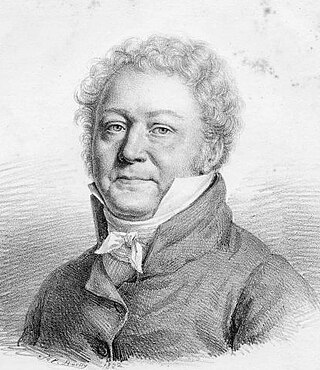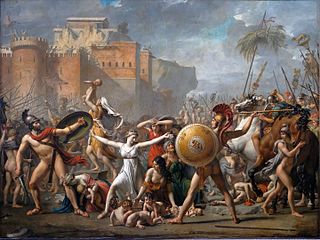
The House of Bonaparte is a former imperial and royal European dynasty of Italian origin. It was founded in 1804 by Napoleon I, the son of Corsican nobleman Carlo Buonaparte and Letizia Buonaparte. Napoleon was a French military leader who rose to power during the French Revolution and who, in 1804, transformed the French First Republic into the First French Empire, five years after his coup d'état of November 1799. Napoleon and the Grande Armée had to fight against every major European power and dominated continental Europe through a series of military victories during the Napoleonic Wars. He installed members of his family on the thrones of client states, expanding the power of the dynasty.

Jean-Antoine Houdon was a French neoclassical sculptor.

The Prix de Rome or Grand Prix de Rome was a French scholarship for arts students, initially for painters and sculptors, that was established in 1663 during the reign of Louis XIV of France. Winners were awarded a bursary that allowed them to stay in Rome for three to five years at the expense of the state. The prize was extended to architecture in 1720, music in 1803 and engraving in 1804. The prestigious award was abolished in 1968 by André Malraux, then Minister of Culture, following the May 68 riots that called for cultural change.

The Académie royale de peinture et de sculpture was founded in 1648 in Paris, France. It was the premier art institution of France during the latter part of the Ancien Régime until it was abolished in 1793 during the French Revolution. It included most of the important painters and sculptors, maintained almost total control of teaching and exhibitions, and afforded its members preference in royal commissions.

Paul Dubois was a French sculptor and painter from Nogent-sur-Seine. His works were mainly sculptures and statues, and he was also a portrait painter.

Antoine-Denis Chaudet was a French sculptor who worked in the neoclassical style. He was born and died in Paris.
Josquin des Prez was a composer of High Renaissance music

Louis-Ernest Barrias was a French sculptor of the Beaux-Arts school. In 1865 Barrias won the Prix de Rome for study at the French Academy in Rome.

Louis Jean Desprez was a French painter and architect who worked in Sweden during the last twenty years of his life.

Guillaume Coustou the Younger was a French sculptor of the late French Baroque or Style Louis XIV, and early neo-classicism.
The year 1804 in art involved some significant artistic events and new works.

Jean-Baptiste Count de Belloy was an Archbishop of Paris and cardinal of the Catholic Church.

Guillaume Guillon-Lethière was a French Neoclassical painter.

François-Frédéric Lemot was a French sculptor, working in the Neoclassical style.

Louis-Pierre Deseine (1749–1822) was a French sculptor, who was born and died in Paris. He is known above all for his portrait busts and imaginary portraits.

The Intervention of the Sabine Women is a 1799 painting by the French painter Jacques-Louis David, showing a legendary episode following the abduction of the Sabine women by the founding generation of Rome.

The Church of the Val-de-Grâce is a Roman Catholic church in the 5th arrondissement of Paris. The church was originally proposed as part of a royal abbey by Anne of Austria, the Queen of France, to celebrate the birth of her son, Louis XIV in 1638. It was begun in 1645 by the architect François Mansart, and completed in 1665 by Gabriel Le Duc. The abbey and church were turned into a hospital during the French Revolution. and then became part of the Val-de-Grâce Hospital, which was closed in 1979. The church is attached to the diocese of the French military, and is open to visitors at certain hours. Its dome is a landmark in the skyline of Paris.
Auguste-Marie Taunay (1768–1824) was a French sculptor.

Louis-Félix Chabaud (1824–1902) was a French sculptor, engraver and medallist.

Julien Florian Félix Desprez, who used the name Florian Desprez (14 April 1807 – 21 January 1895) was a French prelate of the Catholic Church, who became a bishop in 1850, first in Réunion from 1850 to 1857 and then in Limoges until 1859. He spent 36 years of his ecclesiastical career as archbishop of Toulouse from 1859 to 1895. He was made a cardinal in 1879.

















